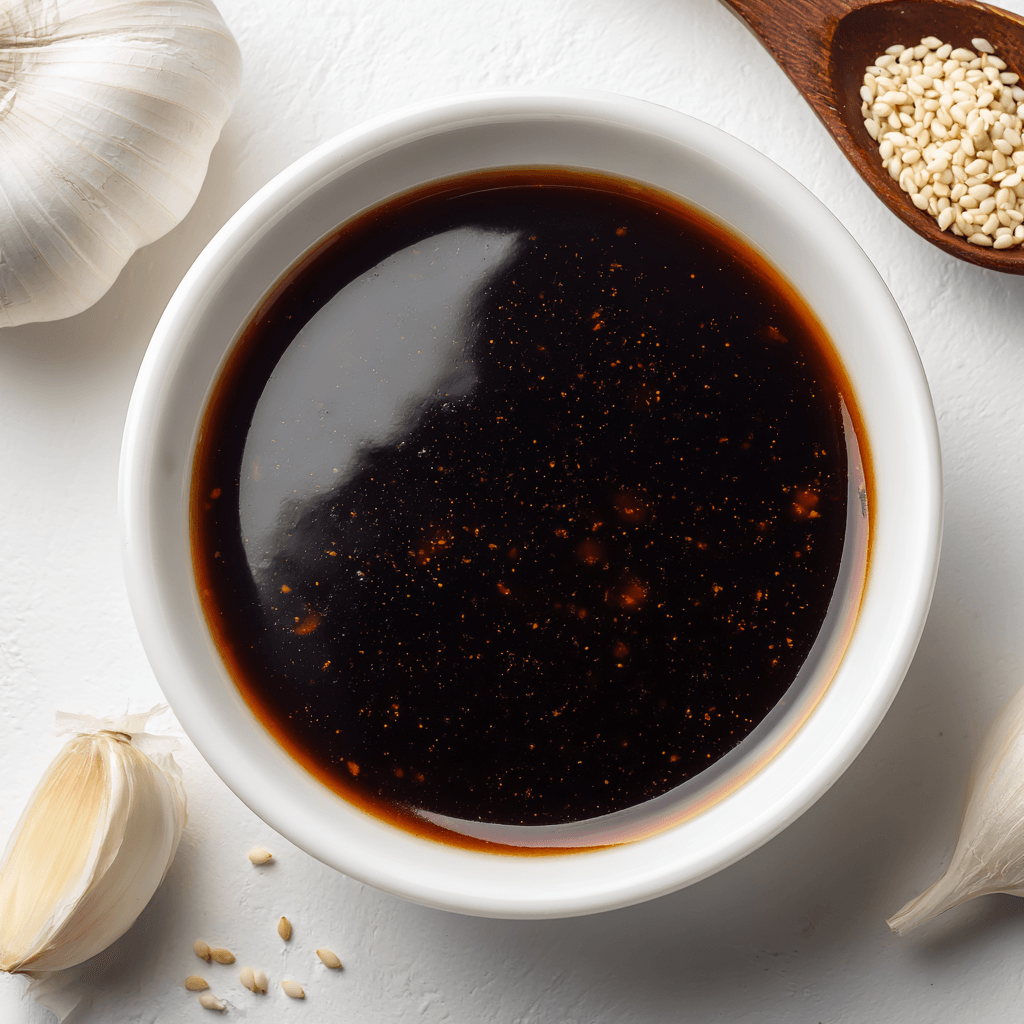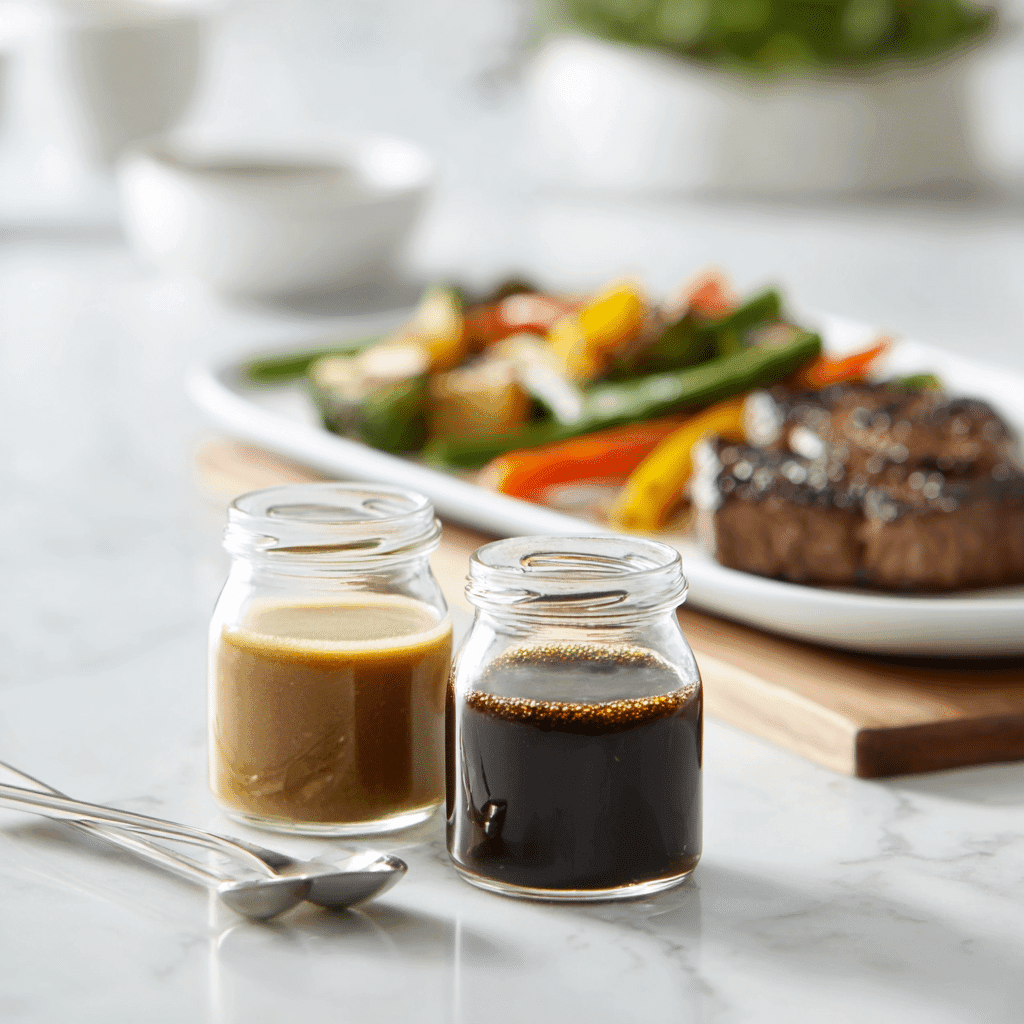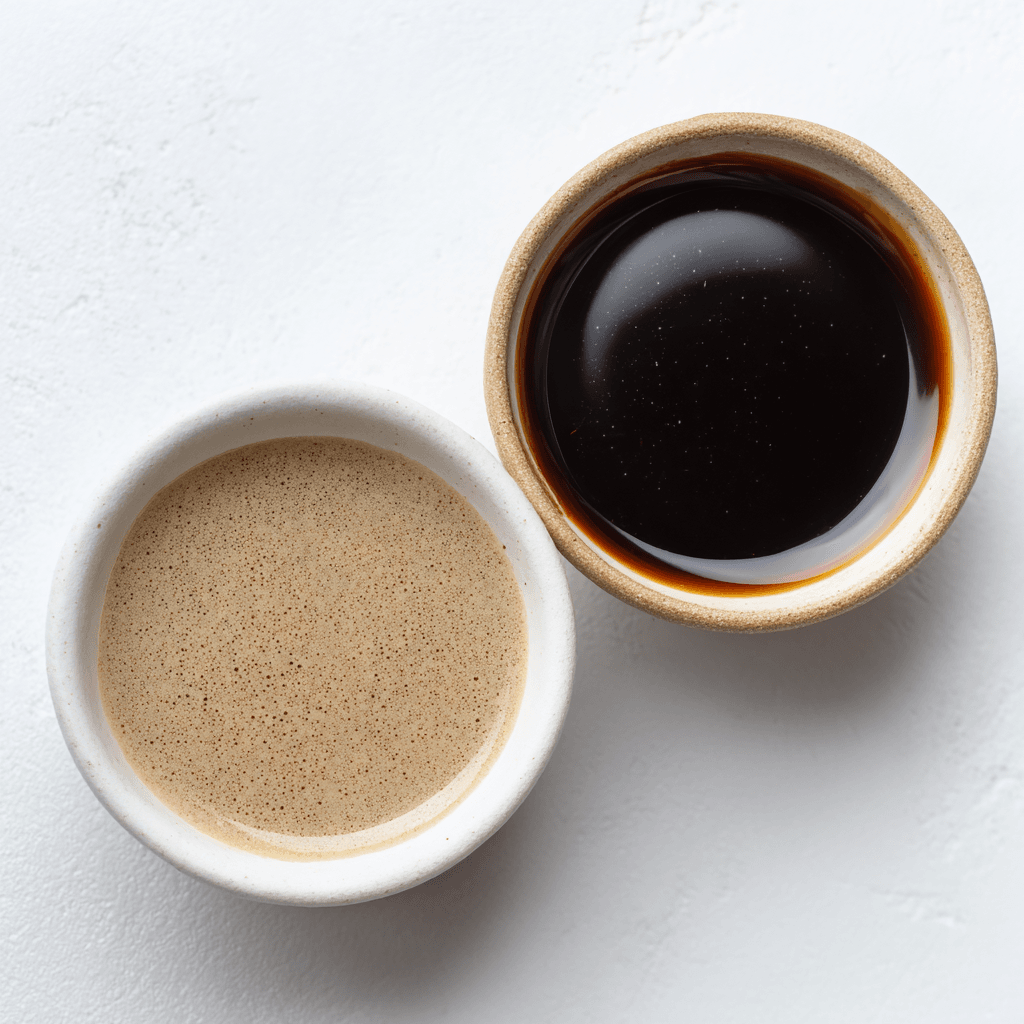Hibachi sauce recipe lovers know that the secret to unforgettable Japanese steakhouse flavor lies in the sauce. Whether it’s the zesty ginger dip, the rich brown sauce, or the creamy mustard favorite, hibachi sauces make every bite come alive.
This easy homemade version brings that restaurant-quality flavor straight to your kitchen—perfect for grilled steak, shrimp, or veggies.
Table of Contents
What is Hibachi Sauce? (Ginger vs Brown vs Mustard)
At Japanese steakhouses like Benihana, the magic isn’t just in the sizzling grill—it’s in the sauces. A classic hibachi sauce recipe brings bold flavor to every bite, whether you’re dipping steak, shrimp, or veggies.
These sauces define teppanyaki-style cooking, where the chef grills food right in front of you and serves it with signature house-made condiments.
Here’s the breakdown:
- Ginger Sauce: Bright, tangy, and a little spicy. Made with fresh ginger, onion, soy sauce, and rice vinegar. Perfect for shrimp and vegetables.
- Brown Sauce: Deep, savory, and umami-rich. Blended from soy sauce, garlic, and sesame oil—it’s the go-to for steak or fried rice.
- Mustard Sauce: Creamy and tangy, with Dijon mustard, mayo, and a hint of soy. Ideal for dipping chicken or seafood.
These sauces work as both dipping sauces and marinades, making them versatile staples for any home cook.
Pro Tip: Combine a spoonful of each for a custom blend that balances brightness and savory depth.
If you love Japanese-inspired meals, pair these sauces with our hibachi fried rice for the full steakhouse experience. Or serve them alongside air fryer chicken bites for a quick, restaurant-style dinner at home.
Hibachi Ginger Sauce (Bright & Tangy)

This hibachi ginger sauce is the zesty, refreshing dip you’ll always find at Japanese steakhouses. It’s light, aromatic, and adds a citrusy kick that pairs perfectly with grilled shrimp, chicken, or veggies. Making it at home takes less than five minutes with a blender and a few fresh ingredients.
Ingredients
- 1 small yellow onion (roughly chopped)
- 2 tbsp fresh ginger (peeled and sliced)
- 2 garlic cloves
- ¼ cup soy sauce (or tamari for gluten-free)
- 3 tbsp rice vinegar
- 1 tbsp lemon juice
- 1 tbsp honey (or maple syrup for vegan option)
Instructions
- Add all ingredients to a blender or food processor.
- Blend until smooth and slightly frothy.
- Adjust seasoning—add more ginger for heat or a splash of rice vinegar for brightness.
- Chill before serving for the best flavor.
This Benihana-style ginger sauce keeps well in the fridge for up to 5–7 days. It’s perfect as a dipping sauce for shrimp, grilled veggies, or drizzle over hibachi fried rice for that signature tangy balance.
For another fresh, Asian-inspired flavor combo, try it with air fryer teriyaki chicken or serve alongside shrimp fried rice for a full teppanyaki-style meal at home.
Hibachi Brown Sauce (Savory & Umami)

If you’ve ever wondered what gives hibachi steak that deep, savory glaze, it’s the hibachi brown sauce. This rich, umami-packed sauce combines soy, sesame, garlic, and a hint of lemon for a flavor that clings perfectly to meat and rice. It’s bold, balanced, and easy to make with everyday ingredients.
Ingredients
- ½ cup soy sauce (or low-sodium soy for balance)
- 1 tbsp sesame oil
- 1 tbsp rice vinegar
- 1 tsp grated ginger
- 1 garlic clove, minced
- 1 tbsp brown sugar
- 1 tbsp lemon juice
- Optional: 1 tsp cornstarch + 2 tbsp water for a thicker texture
Instructions
- In a small saucepan, whisk together all ingredients over medium heat.
- Bring to a gentle simmer for 3–4 minutes until the sauce slightly thickens.
- Remove from heat and let it cool. It will continue to thicken as it rests.
- Serve warm or chilled as a dipping sauce or marinade.
This hibachi brown sauce recipe pairs beautifully with grilled steak, sautéed vegetables, or hibachi fried rice. You can also drizzle it over baked boneless chicken thighs for a quick, restaurant-quality dinner.
How to Use Hibachi Sauce ( Delicious Ideas)

This hibachi sauce recipe is a flavor powerhouse that elevates everything from steak to vegetables. Both the ginger and brown sauces bring versatility—sweet, tangy, and umami-rich—making them ideal for dipping, drizzling, or marinating your favorite dishes.
Delicious Ways to Use It
- Steak & Chicken: Brush hibachi brown sauce over grilled steak or seared chicken for a bold, savory finish.
- Seafood: Use ginger sauce as a dip for shrimp, scallops, or salmon. It adds freshness that balances rich seafood flavors.
- Vegetables: Toss roasted zucchini, carrots, or cauliflower in either sauce for instant Japanese-style sides.
- Rice & Noodles: Mix a spoonful into rice, lo mein, or yakisoba noodles for that classic hibachi-style depth.
- Tofu & Plant-Based Dishes: Marinate tofu or tempeh in the brown sauce before grilling—it soaks up flavor beautifully.
- Meal Prep & Bowls: Use both sauces to dress up grain bowls, wraps, or Buddha bowls for quick weekday lunches.
For a full hibachi-style experience at home, pair your sauce with our air fryer roasted sweet potatoes for a caramelized side or drizzle over pesto tortellini pasta salad for a surprising East-meets-Med twist.
Make It Your Way: Gluten-Free, Vegan, Low Sodium
This hibachi sauce recipe can easily fit into any diet—vegan, gluten-free, or low-sodium. With a few simple swaps, you can enjoy all the bold hibachi flavors without sacrificing your dietary goals.
Easy Adaptations
- Gluten-Free Hibachi Sauce: Replace soy sauce with tamari or coconut aminos. Both keep the same savory depth while cutting out gluten completely.
- Vegan Hibachi Sauce: Substitute honey with maple syrup or agave nectar for sweetness that’s 100% plant-based.
- Low-Sodium Version: Use low-sodium soy sauce or dilute regular soy sauce with a splash of water. Add flavor back in with ginger, garlic, and a hint of lemon juice.
- Soy-Free Option: Try coconut aminos as a direct swap—it delivers that same umami kick without soy or wheat.
- Clean-Label Advantage: Homemade sauce skips preservatives, MSG, and stabilizers often found in bottled brands.
This flexibility makes hibachi sauce a smart choice for family meals, batch cooking, or weekly meal prep. Pair your sauce with air fryer turkey meatballs for a low-carb dinner, or drizzle it over big mac salad for a lighter take on fusion flavor.
Storage Tips + Batch Prep
Homemade sauces taste best when stored right—and this hibachi sauce recipe is no exception. Whether you make the ginger or brown version, proper storage keeps the flavor bright and balanced for weeks.
How to Store Hibachi Sauce
- Refrigerate: Pour your sauce into a mason jar or airtight container. It stays fresh in the fridge for 5–7 days.
- Freeze: For long-term use, freeze portions in ice cube trays. Once frozen, pop them into freezer bags for easy use later.
- Thaw & Reheat: Let frozen cubes thaw overnight in the fridge, or warm gently on the stove. Stir before serving to bring the flavor back to life.
- Avoid Plastic: Glass jars preserve flavor better and prevent absorption of odors.
Batch Prep Tips
- Double or Triple: Make larger batches to have both ginger and brown sauces on hand for meal prep.
- Label & Date: Always write the prep date on jars—it helps track freshness.
- Meal Prep Ready: These sauces work great with rice bowls, grilled proteins, or veggie stir-fries.
Pair your freshly made sauce with one-pot chicken and rice for a full, flavorful dinner, or use it to top cottage cheese pasta for a high-protein, fusion-inspired twist.
Frequently Asked Questions
1. What is used in hibachi sauce?
A classic hibachi sauce recipe uses a base of soy sauce, ginger, garlic, and rice vinegar. Some versions add sesame oil, onion, or brown sugar for balance. Restaurants often serve two main types—ginger (bright and tangy) and brown (rich and umami).
2. What do hibachi chefs squirt on rice?
Chefs typically use a mix of soy sauce and butter or garlic oil to flavor hibachi rice. It gives that signature glossy finish and savory taste.
3. What is the brown sauce they put on hibachi?
That’s the famous hibachi brown sauce—a savory blend of soy sauce, sesame oil, garlic, ginger, and rice vinegar. It’s slightly sweet and loaded with umami, making it ideal for steak, chicken, and vegetables.
4. What liquid do hibachi chefs use?
Hibachi chefs use soy sauce, mirin, and a touch of rice wine vinegar while cooking. These liquids deglaze the grill and enhance the food’s caramelized flavors.
Bringing Japanese Steakhouse Flavor Home

This hibachi sauce recipe proves you don’t need a flat-top grill to get that iconic Japanese steakhouse flavor. With two easy sauces—ginger and brown—you can turn simple meals into restaurant-worthy dishes. Sweet, savory, and tangy, these homemade sauces make every bite pop with umami.
Both sauces come together in minutes using pantry staples, and they keep beautifully for meal prep. Whether you drizzle them over steak, toss them with rice, or dip fresh veggies, you’ll capture that signature teppanyaki taste right in your own kitchen.

Hibachi Sauce (Ginger & Brown)
Ingredients
Equipment
Method
- Hibachi Ginger Sauce: add chopped onion, fresh ginger, garlic, soy sauce, rice vinegar, lemon juice, and honey (or maple syrup) to a blender or food processor.
- Blend until smooth and slightly frothy, then taste and adjust: more ginger for heat, more rice vinegar for brightness, or more honey for sweetness.
- Chill the ginger sauce at least 15 minutes (optional) and store in the refrigerator for 5–7 days.
- Hibachi Brown Sauce: whisk together soy sauce, sesame oil, rice vinegar, grated ginger, minced garlic, brown sugar, and lemon juice in a small saucepan.
- Bring the mixture to a gentle simmer over medium heat and cook for 3–4 minutes, stirring, until slightly reduced. If a thicker sauce is desired, whisk together 1 tsp cornstarch and 2 tbsp water and stir into the simmering sauce until it thickens.
- Remove from heat, let cool slightly (it will continue to thicken), then transfer to a jar and refrigerate. Keeps about 5–7 days.
- Serving suggestions: use ginger sauce as a dip for shrimp and vegetables or drizzle over rice; use brown sauce to brush on steak, toss with fried rice, or serve as a dipping sauce.
- Adaptations: for gluten-free use tamari or coconut aminos; for vegan swap honey for maple syrup; for low-sodium use low-sodium soy and increase vinegar/ginger to maintain flavor.
Nutrition
Notes
- Ginger sauce: blend until smooth and chill for best flavor (keeps 5–7 days).
- Brown sauce: simmer briefly (3–4 minutes) and cool; it thickens as it rests.
- Gluten-free: use tamari or coconut aminos. Vegan: swap honey for maple syrup.
- To thicken brown sauce, mix 1 tsp cornstarch with 2 tbsp water and whisk in at the end while simmering.
- Store in a sealed jar in the refrigerator.
Tried this recipe?
Let us know how it was!Looking for more comfort recipe like this? Come hang out with me over on Facebook and Pinterest where I drop new recipes, family favorites, and quick how-to guides almost every day.


2 thoughts on “Best Hibachi Sauce Recipe – Ginger & Brown Copycat”